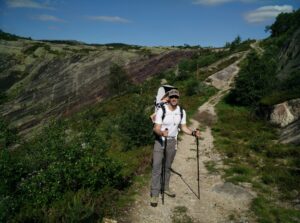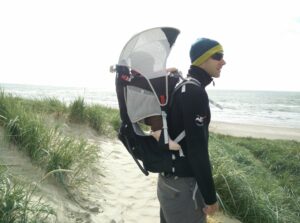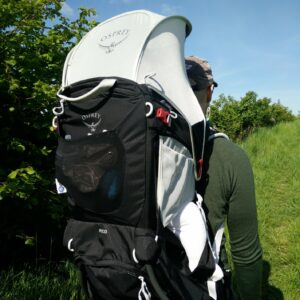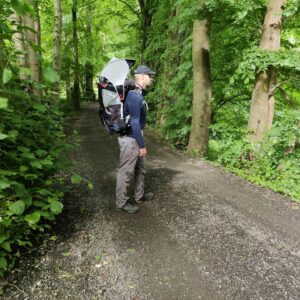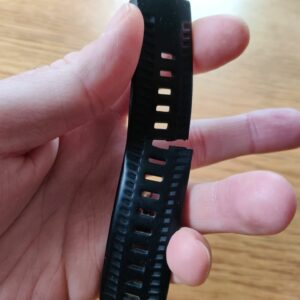In mid-September 2019 I gave birth to our daughter MK, and five months after I wrote the article Hiking Pregnant: Tips and Advice about the things which made hiking pregnant comfortable for me (and hopefully the not-yet born baby as well). Thus, we thought it was about time to make an article about the tips and things which made hiking with our baby enjoyable. In the coming years we are planning to make similar articles like Hiking with a toddler, Hiking with an annoying 6-year old, Hiking with a reluctant teenager etc. But for now, we are focusing on the period from when she could sit up unaided (around seven months), where it was safe to put her in an actual child carrier backpack till she started walking (13 months old).
You can of course hike/take walks earlier with the baby in a suitable baby carrier (or stroller on pruned paths), but for using a child carrier backpack he/she must have good head control and be able to sit up unaided; otherwise the baby’s back and hips might suffer in their development. The advantage of a child carrier backpack compared to “soft” baby/child carriers is that the metal frame inside the back panel helps to efficiently transfer the weight of the heavy backpack from your shoulders to your hips via the hip belt. This delays exhaustion, and enables longer and more challenging hikes. If you are looking for such a pack, we have made a list of the best child carrier backpacks for hiking currently available on the market. We chose the Osprey Poco (check out the first-hand review here), which my boyfriend mainly has been the one to carry.
Hiking with a Baby: Tips and Advice
- Choosing the right trail and be ready to make a stop whenever, wherever
- Making the baby ready for the hike I: Clothing
- Making the baby ready for the hike II: Sun protection
- (Breast)feeding on the go
- Nappy changing on the go
- Bring a crappy, but durable sleeping bag
- Toys are not (yet) that important
Choosing the right trail and be ready to make a stop whenever, wherever
When you start hiking with a baby, you should start slow with shorter trails where you can easily turn around and/or shorten the hike, if the little one gets very annoyed with sitting in the child carrier. There is nothing delightful about hiking with an angry child, screaming into your ears as you go, so it’s better to change the plan accordingly although it can be frustrating to cut things short. Our first longer hike (10 km/6 miles) with MK was at Agri Bavnehøj in the Danish Mols Bjerge National Park and took several hours, but had multiple stops. Before that, we did, however, prepare by going on several shorter hikes of around 5 kilometers, for the duration of an hour or so to get MK used to sitting in the child carrier. In the beginning she would usually fall asleep, regardless if it was nap-time or not, but later she had quite long stretches being awake and content. The napping time is, nevertheless, usually the time where you can really get some hiking done, so do take advantage of that.
Making the baby ready for the hike I: Clothing
Since the child is not going to be active as such during the hike, you can dress it in the quintessential baby fabric: cotton – which we otherwise advise against for adult hikers. But the best base layer material – also for babies – is Merino wool, which besides being soft, breathable and odor-resistant, offers natural sun protection. If you do dress the child in very thin cotton, you should probably apply sun cream underneath. Regardless of material, you should always dress the baby in long sleeves and trousers, no matter how warm it is, to avoid arms and legs getting sunburned. If it is windy, try to at least find a pair of somewhat wind-resistant trousers in a tightly woven fabric as the legs will be the most exposed. In very windy weather, the best option might be to put the rain cover over the child carrier backpack to shield your baby adequately. Babies should not wear shoes with rigid soles until they can walk more than a few steps unaided, but make sure their feet are covered, warm and comfortable in socks or soft shoes/boots. A weather-appropriate hat is always necessary – especially one that the little bugger can’t get off by its own devices.
Making the baby ready for the hike II: Sun Protection
Most high-quality child carrier backpacks feature an integrated sun shade which you can deploy according to the weather, but you should, nevertheless, make sure that your baby is protected against the sun on its own. That means dressing him or her in sun-protective clothing (for example light-weight Merino wool), using a hat suitable for the expected temperatures, and putting sun cream with a high SPF (at least SPF30, preferably SPF50) on face, hands and anywhere else the child is exposed. Sun cream is safe to use on babies aged six months and older, but opt for one with a physical filter (meaning that the active sun shielding ingredient is titanium dioxide and/or zinc oxide, but nothing else), and without fragrance/perfume and very little or no alcohol in it (meaning that it should not be listed as one of the first five ingredients). When you have to make a stop, do try to find somewhere with shade or provide it for the child by shielding it with your body, the backpack etc.
(Breast)feeding on the go
Besides dressing the child appropriately, the mother should also be dressed for breastfeeding on the go – if she is (still) nursing. I myself have been very thankful for the nursing bras (one Merino, one synthetic) and long-sleeved Merino top from Boob Design, which made access to the breasts fast and comfortable. Also in nature, breastfeeding is a great way to calm down an upset baby! If you are giving formula, you can either bring powder in a small bag or packages of ready to drink formula, depending on your (child’s) preference. If the child is not (yet) used to drink formula at room temperature, you can bring an insulated vacuum bottle with boiled water to heat the formula to the desired temperature. Depending how far along the little one is with eating solid food, you can bring different snacks such as pouches (or home-made tubs) of smoothie, porridge and vegetable puree as well as cut fruit, vegetables or those unsalted baby chips (which taste like polystyrene). Bring lots of water, both for drinking and doing light cleaning on whichever surfaces baby will stain with food etc.
Nappy changing on the go
Depending on the duration of the hike, you will probably have to change one or more diapers. Bring a thick blanket or sleeping bag (see more below), which provide a bit of cushioning for all of you to lounge on during breaks, and one or two small towels (or disposable nappy changing mats) specifically for diaper changes. Parents have various methods and means to wipe and clean their babies’ bottoms, like cotton pads, cotton wool, foam cloths, wash cloths or wet wipes – and you should of course stick to your preferred method, but remember to bring enough trash bags to keep for example used disposable diapers and soiled wash cloths separate. Again, a thermos bottle with warm water might come in handy for cleaning the child properly. Be sure to dispose of all trash in proper bins, as it for example takes nothing less than 450 years (!) for a disposable diaper to degrade in nature.
Bring a crappy, but durable sleeping bag
At Nail the Trail we usually only guide you to the best hiking gear and apparel to stay true to our name, but for once we advise you to get a piece of inexpensive gear of questionable quality. The thing is that we have great use of the crappy sleeping bag we originally bought for hiking in Iceland (which did next to nothing to stop us from freezing in the night) as a picnic blanket when it is necessary to make a stop to take care of the little one’s needs (feeding, diaper changes, playtime out of the backpack etc.). It’s great to have piece of gear where you don’t care about which surface you put it on or which stains that might occur. When you need to make a stop, you shouldn’t have to fuzz over where to put the sleeping bag or take great care that it doesn’t get stained from food, drinks, pee, poop, puke or any of the other stains a baby can provide. Be sure to choose a sleeping bag with synthetic insulation, so washing and drying will be completely hassle-free.
Toys are not (yet) that important
Babies are usually curious and interested to observe the landscape they are being carried through, and thus you might find (like us) that you don’t need to bring an entire toy box for the hike. One or two beloved things which can be attached to the backpack with a carabineer or HeroClip is more than enough. Make sure that the toy is within reach on the go, but not in a way that could prove dangerous for the little one. Once you make a stop, you can detach the toy and give it to the baby, but most of all you should engage yourself in encouraging your child to move around on its own, so he/she can stretch and get the circulation going after having been carried for a while. It is crucial that the child carrier backpack has stirrups for the child, so it avoids suffering from pins and needles in the feet and legs from poor circulation, but a bit of active play will help to improve the circulation and well-being.
